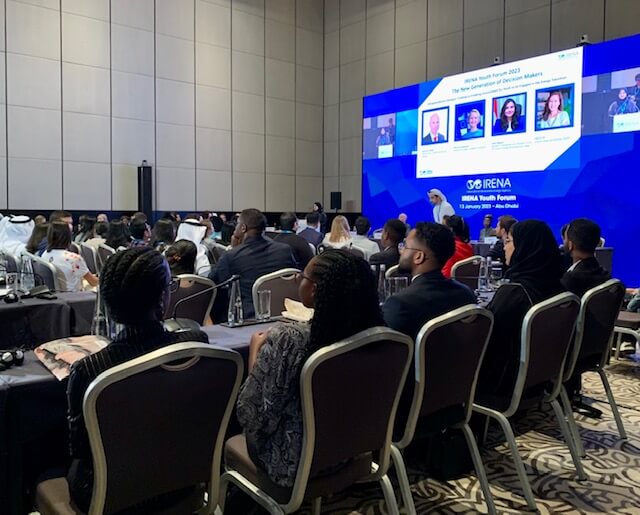ABU DHABI, United Arab Emirates — Greta Thunberg, the Swedish climate change canary, didn’t participate in the 13th assembly of the International Renewable Energy Agency (IRENA), held in Abu Dhabi on Jan. 14 to 15. Perhaps it was because she was otherwise engaged in protesting against the razing of the German village of Lützerath for the expansion of a coal mine.
No matter. The urgency always in Thunberg’s voice on climate change was heard all over the assembly, from COP28 President-designate Sultan al-Jaber of the United Arab Emirates saying in a session, “Over the next seven years, we will need to more than triple renewable generating capacity worldwide. The world must move much faster than ever before,” to U.S. climate envoy John Kerry insisting in another session that not enough money was being “put on the table” to achieve net-zero targets.
“We’re either not trying to do it or we’re trying to do it on the cheap, and the result is that we’re not doing it,” Kerry said. “The system is broken in terms of how we’re trying to fix this, and we need to respond more effectively.”
Among the 1,500 or so high-flier participants at the assembly, convened to identify energy transition priorities in preparation for the Global Stocktake of the Paris Agreement on climate change, were hundreds of fledglings — youths from all over the world, ranging from high schoolers to ministers of parliaments under the age of 45 — all eager to get into the energy transition formation.
Ernest Mkhonta, managing director of Eswatini Electric Company, told me, “Actually, I think youth should be leading the formation.”
For the fourth time at its assembly, Abu Dhabi-based IRENA, a lead intergovernmental agency for energy transformation, whose membership comprises 167 states and the European Union, has held a youth forum. At this one, young people heard from a diverse panel on how to move from demonstrating to decision-making in an equitable energy transition.
Passy Amayo Ogolla, a program manager leading implementation of the Sustainable Energy Futures for Eastern Africa Program at the Society for International Development, echoing some of Thunberg’s angry statements on the world dawdling on pathway to limit global warming to 1.5 degrees C (2.7 degrees F), said bluntly at the forum, “Friends, we’re running out of time.”
Ogolla, who serves as vice chair of IRENA Global Council on Enabling Youth Action for SDG7 (ensuring access to affordable, reliable, sustainable and modern energy for all is the seventh of the sustainable development goals established by the United Nations General Assembly in 2015), noted that today, there are 1.2 billion young people aged 15 to 24 years, accounting for 16 percent of the global population. By 2030 — the target date for the SDGs that make up the UN 2030 agenda — the number of youth is projected to have grown by 7 percent, to nearly 1.3 billion.
“We must run faster and hold world leaders accountable in the energy transition. We need to create the change that we need for an equitable energy future for all,” she said.
Hans Olav Ibrekk, Norway’s special envoy for climate and security, who called himself an “old-timer” but wanted to be addressed by his first name, said it was great to see young people from 15o countries in the room and “willing to take on the mess that my generation has created. You definitely have your work cut out for you.”
Ibrekk commended IRENA for creating the youth forum, saying, “We need a new dialog between youth and decision-makers in order to accelerate the energy transition.”
After COP27, he said, the message is that the world needs action and radical solutions: “We need all hands on deck, and we need agents of change. … You represent untapped youth potential for the energy transition.”
Political institutions, for their part, need to make sure that all voices are heard, Ibrekk said. “We can hear you, but we don’t really listen to you.” He urged young people to be responsible and engage in the political process, particularly by voting.
Attracting young talent is one of the major challenges of the energy transition. “We don’t have enough [technically] trained people to do what we have to do,” Ibrekk said. He encouraged young people in the room to pursue “careers of relevance in the energy sector.”
Digitization in the energy sector, he said for example, “offers a huge potential for young people to play an active role in the transition. “We old-timers are not really used to this,” he admitted, “You should use your comparative advantage in this area.” He added that as older energy sector workers retire, “there will be plenty of empty seats in offices” to fill.
The theme of the youth forum was “Empowering Youth To Lead an Equitable and Sustainable Energy Future.” Ditte Juul Jorgensen, European Commission director general for energy, said renewables can be “local and global at the same time.”An example: rooftop solar. “There is a huge potential in renewables to benefit everyone,” she said.
A European Union concern is that in order for renewables to be accessed universally — a key policy point — countries need more access to power generation, including wind turbines, Jorgensen said.
Sahar Albazar, a member of Egypt’s parliament, said the Inter-Parliamentary Union Forum of Young Parliamentarians, for which she serves as president, advocates with governments to “put youth in the driver’s seat” in the energy transition.
She noted that the group of 24,000 MPs under the age of 45 is focusing on the need for wind, solar, carbon capture, and new technologies that help to reduce greenhouse gas emissions.
Having young MPs versed in renewable energy means “we can work with our tools and power to allocate the budgets for things we want to focus on, both locally and nationally, and to put in more incentives for private and world investments,” she said.
Asked how those who haven’t flown up to being MPs can have a place at the decision-making table, Albazar replied, “Can I have a show of hands of those who know the term ‘entrepreneur’?” Hands flew up all over the room.
“So you know the energy that entrepreneurs bring to business and innovation. We need political entrepreneurs, innovators,” she said.
Albazar said her group of young MPs is urging parliaments to use some of its six tools empower young people. The first, she cited, is to get young people into leadership positions. “We want the age to run for office to be equal to the age to vote,” she said, noting that in some countries, 18 is the voting age, but the candidacy age is 24 or 25.
She said her group is also working to get parliaments to mentor young MPs and to create youth caucuses or committees. “We have your back,” she said.
The final speaker, Felicity Tan, director of global partnerships at the Global Energy Alliance for People and Planet, said her group is working on access to energy.
“Whether it is health, education, empowerment, or whatever you are working on, without energy, it isn’t possible,” she said. “At the same time, by our estimates, about half of the planet doesn’t have access … 3.85 billion people. And that is the North-South access divide right there.”
The alliance is working with IRENA, which is among 19 global partners (governmental, financial, investors), on three specific areas for youth empowerment in the energy transition: education, training and technical skills, and advocacy — “not just giving youth a voice, but giving them agency.”
The first Global Stocktake will be held at the 2023 UN Climate Change Conference (COP28), taking place in Abu Dhabi from Nov. 30 to Dec. 12.




